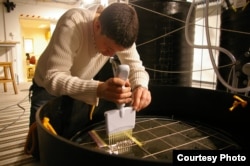Climate change is never as simple as 'the world is getting warmer'; it is a complicated string of cause and effect.
And a new study suggests one of those strings could have a huge impact on some of the seafood we eat.
Extreme weather, extreme runoff
The new research is a collaboration between researchers at Umeå University and the Swedish University of Agricultural Sciences, and is being published today in the journal Science Advances.
It points to a link between extreme weather, increased water runoff and potentially massive increases in the levels of dangerous mercury in “coastal zones, coastal seas and lakes” -- any areas, lead author Erik Björn told VOA “which receives large input from runoff.”
The study comes to its conclusions based on evidence that predicts that “global warming is expected to increase runoff and input of organic matter to aquatic ecosystems in large regions of the Northern hemisphere…”
That 15 to 30 percent increase in water off of farms and lawns and roads, the study says, will cloud ocean water, resulting in “reductions in the production of phytoplankton via photosynthesis.” Phytoplanktons serve as the primary bottom rung of the food chain throughout the world’s oceans and lakes.
With less sunlight and a lot of organic material, the environment begins to favor bacteria called zooplankton which feed on all the junk washed into the water.
That’s bad for two reasons: the first is that the runoff carries “a greater discharge of mercury and organic carbon to coastal ecosystems, which leads to higher levels of mercury in the small animals living there.” The study estimates the amount of mercury in zooplankton could jump “by 200 to 700 percent.”
Second, all that runoff means animals that were eating primarily phytoplankton have to eat more zooplankton, and that means even more mercury gets into their systems, and up and up through the food chain.
From the water to the dinner table
It is hard to overestimate the negative effects that mercury has on humans, especially children. Speaking with VOA, Björn laid out just how dangerous the chemical is: “Mercury is considered one of the top ten chemicals of public health concern by the World Health Organization.”
In the European Union, he notes, “1.8 million children are born each year with prenatal exposure levels of methylmercury considered unsafe.” And the adverse effects of mercury poisoning in the EU are “estimated to [vost] 90 million Euro per year.”
Those numbers are current, he says, and if climate change leads to increased erosion, the health effects will get worse and the associated price tag, higher.
One quick note, the climate change model the team used assumes we keep pumping carbon into the atmosphere at the same rate we do today. If we cut back on emissions, it could lower the amount of mercury that ends up on our dinner table.
Björn also pointed to global efforts like the 2013 Minamata Convention on Mercury, signed by 128 countries and ratified by 36 with a sense of optimism. It deeply restricts mercury mining, its use and its disposal. “We have great hope” he said, that if the convention takes hold, “that the exposure of mercury to ecosystems and humans will decrease in the future.”
The link between climate change, erosion and ultimately more mercury in our systems is long, involved and complicated, just like the climate. But by following the mercury, these researchers present a fascinating cautionary tale of how seemingly unrelated events can lead to unexpected, unintended and dangerous outcomes.









